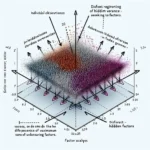Title: Basic Example of Factor Analysis in Cognitive Testing
Factor analysis is a statistical method used to uncover the underlying structure of a relatively large set of variables. Essentially, it is used to discern patterns that help to simplify a complex data set. In the realm of cognitive testing, factor analysis plays a pivotal role in identifying latent constructs that influence observable behaviors and test outcomes.
**Definition and Purpose**
Factor analysis helps researchers and psychologists condense the observed test data into several dimensions or factors, which can represent different cognitive abilities or processes—such as memory, reasoning, or verbal aptitude. By analyzing the correlations among test items, it becomes possible to cluster items together under common factors, thereby streamlining the assessment and interpretation of cognitive tests.
**Example of Factor Analysis in Practice**
A basic example of factor analysis in cognitive testing might involve a set of mental ability assessments, each consisting of various questions that gauge different aspects of cognitive skills. As individuals respond to these items, their responses will naturally correlate if the items tap into the same cognitive ability. For instance, questions that require participants to manipulate and remember verbal information may display high correlation, suggesting they measure a related construct, which could be named “Verbal Working Memory”.
**Steps in Conducting Factor Analysis**
The process typically begins with the collection of test data, followed by the calculation of correlations among test items. The factor analysis employs a mathematical technique, such as principal component analysis (PCA) or principal axis factor analysis (PAF), to extract the initial factors. Then, rotation methods like Varimax or Oblimin are applied to achieve a more interpretable factor structure. From this structure, certain items that are closely interrelated can be seen as indicators of a particular cognitive function.
**Applications and Interpretations**
Understanding which tests are grouped under specific factors can aid in the development and refinement of cognitive tests. For instance, if a test intended to measure mathematical reasoning also loads heavily on a verbal factor, it may imply that the test requires significant verbal skills, potentially skewing results. As a result, researchers might decide to revise the test to better isolate the intended cognitive ability.
The output of factor analysis, such as factor loadings and eigenvalues, guide the selection of which factors to retain or discard. In turn, these decisions impact the overall testing framework, leading to more accurate assessments that can be used for a variety of purposes, including educational settings, clinical diagnosis, and research into cognitive processes.
**Conclusion**
Factor analysis is an indispensable tool in cognitive testing that aids in the measurement and understanding of the multifaceted nature of human cognition. The process allows for the structuring and simplification of data, leading to more precise and targeted assessments. As cognitive testing continues to evolve, factor analysis remains foundational in the quest to uncover the complexities of the human mind.

